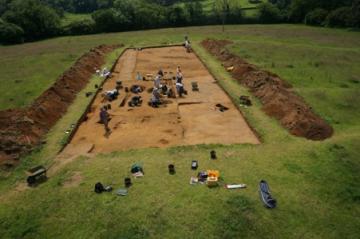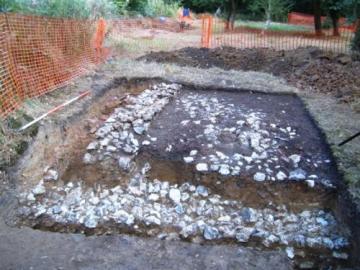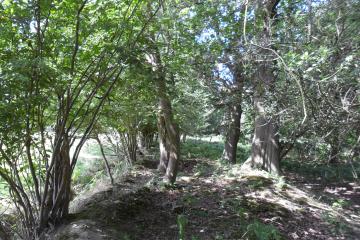Research & Fieldwork Reports - by date of work
The articles below record research and fieldwork undertaken by the Society. Many have not been published elsewhere. Click on the item header or the 'Read more' link to read the complete article. The articles are arranged in descending order of the work done, NOT the date of publication.
A probable medieval ironworking site at Lower Mousehill Lane, Milford, Surrey 2014
Analytical survey of earthworks on Gravelly Hill, Caterham 2014
In 2014 land on Gravelly Hill was purchased by Caterham School and they expressed an interest in knowing the archaeological and historical background to their new land. The late Peter Gray had already noted the presence of earthworks within the area but access had previously been limited. As a result of the change of ownership members of the Surrey Archaeological Society undertook aa measured survey of the land within the medieval park and a small area to its immediate north.
Excavations at Cocks Farm Abinger 2014
First of all, a big thank you to everyone who helped to make the latest season at Abinger such a success. It may seem odd to say that in view of our failure to finish the trench, but this was a result of finding that there was more surviving archaeology than anticipated. Much of this must be down to your hard work in tackling the difficulties of finding archaeological features in sand. As a result we have a much better understanding of the site and how to approach it in future.
Margery Wood Earthwork: an archaeological survey 2014
The Heritage Lottery funded a community project, run by Nigel Randall, investigating Reigate Fort on Colley Hill. Surrey Archaeological Society was asked to survey the bank and ditch feature in Margery Wood, for which there was no funding. A pdf of the full report is attached.
2013 Excavations at Ashtead Roman Villa and Tileworks
The final main season of excavation on Ashtead Common was undertaken by the Society’s Roman Studies Group in August and September this year. The ground was very dry at first at the end of the long dry spell, making excavation difficult, but it did allow work in places that would usually have been under water (and indeed were at the end of the dig). The excavation was aimed principally at completing work on the area of the newly discovered building, the Lowther villa and the tile kiln(s).
An analytic survey of Dry Hill Camp 2011-2013
Dry Hill Camp is a large enclosure of probable Iron Age date looking across the Eden/Medway Valley to the northern part of the Low Weald and North Downs. It is multi-vallate and lies just within Surrey, close to both Kent and Mid-Sussex. An excavation in 1932 recovered few finds and the site remained enigmatic. From 2011-2013 a level 3 tape and compass survey to check the condition of the earthworks was undertaken and a report is now available in the pdf attached below.
Daniel Hall, Long Garden Walk, Farnham, 2013
Watching brief by D Graham of SyAS on the conversion of a late 18th century barn in 2013. Apart from a possible clay/chalk floor and signs of an episode of burning, there was no evidence for any activity on the site other than the remains of a shallow brick wall running across the centre of the building. The bricks were relatively modern, but underlay the concrete floor and probably represent the line of an earlier partition wall. It seems likely that the area was either open fields or backlands until the barn was constructed in the late 18th century.
Excavations at Ashtead Roman Villa and Tileworks 2013
The final main season of excavation on Ashtead Common was undertaken by the Society’s Roman Studies Group in August and September this year. The ground was very dry at first at the end of the long dry spell, making excavation difficult, but it did allow work in places that would usually have been under water (and indeed were at the end of the dig). The excavation was aimed principally at completing work on the area of the newly discovered building, the Lowther villa and the tile kiln(s).
Watching brief at 62 Castle Street, Farnham 2013
Watching brief by A and D Graham of SyAS revealed evidence of post-medieval pits and a wall that may represent evidence of a cellar that appeared to pre-date the construction of the current 18th century building.
For more information please view the attached report.
Watching brief Riverside, Farnham 2013
A watchig brief by D Graham of SyAS in advance of the development of the site for car parking and sports facilities found nothing of archaeological interest earlier than the late Victorian period.
For more information please view the attached report




